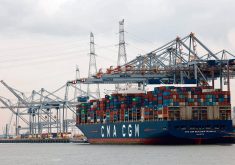Low water levels on the Mississippi River in the United States could have an impact on corn and other grain prices, but are unlikely to affect fertilizer deliveries into Canada, officials say.
The Mississippi River is considered low if the stage falls below five feet in Memphis, Tennessee. On Oct. 20 it hit a record low of -10.74 feet. The stage bounced back to -0.79 feet on Nov. 18, due to rains in Kentucky and Tennessee that made their way into the river basin.
But that relief is expected to be short-lived, with the long-term forecast calling for a return to -7.2 feet by Dec. 15.
Read Also

Smart fertility planning key to soybean yields
Understanding how to tailor fertilizer plans to specific field conditions will be critical for a successful 2026 soybean crop.
The low water levels have limited both the number of barges operating on the river and the weight loaded on those barges. The river system, which feeds ports in the Gulf of Mexico, is critically important for U.S. grain and oilseed exports.
That trade route accounts for 62 per cent of all U.S. corn shipments, 51 per cent of soybean exports and 12 per cent of the wheat leaving the country.
Rich Nelson, chief strategist with Allendale Inc., said the barge restrictions could limit the amount of U.S. grains and oilseeds that make it to market this year. He is particularly concerned about corn exports.
StoneX estimated that as of Nov. 3, corn shipments were 322 million bushels behind the pace needed to meet the U.S. Department of Agriculture’s export target, soybean exports were 76 million bu. off the pace and wheat exports were 18 million bu. behind.
Soybean sales were nine per cent above the five-year average, while actual exports were 10 per cent below average as of Nov. 17.
“We have gotten through our peak shipping season for soybeans and we’re still OK,” he said.
The same can’t be said for corn. Sales are 38 per cent below the five-year average, while exports are running 39 per cent below normal.
Sales to China have been lacklustre after two strong years due to stiff competition from Brazil. Brazilian corn was US$60 per tonne cheaper than U.S. corn through much of October.
That gap has since narrowed to $20 per tonne, but it is still restricting sales. The Mississippi barge problems haven’t helped.
Nelson’s corn balance sheet has 2022-23 ending stocks of 1.258 billion bu., which is higher than USDA’s 1.182 billion bu.
His export number is 50 million bu. below USDA’s, and he also has a lower domestic ethanol usage number. USDA’s ending stocks number implies a $6.85 corn futures price. Nelson’s number equates to a $6.60 price.
But he is concerned USDA could easily reduce its corn export number by another 200 to 300 million bu. in future reports, which would result in corn futures of $5.20-$5.40/bu.
The market has been reluctant to factor in potential U.S. export losses because of the offsetting factor of Argentina’s poor corn crop. But Argentina received decent rainfall in the past few weeks and if that keeps up, the U.S. export problems could start to weigh down prices.
The Mississippi River is also an important conduit for transporting imported fertilizer north from the Gulf of Mexico, raising concerns about North American fertilizer availability.
That doesn’t appear to be an issue for Canadian growers.
“We’re not seeing any impacts from the Mississippi because most of the supply coming from the U.S. is imported by rail,” said Kayla FitzPatrick, spokesperson for Fertilizer Canada.
She said 76 per cent of Canada’s imports from the U.S. are by rail and 24 per cent by truck, and product continues to flow north.
“It seems to be more of an issue impacting supplies in the U.S.,” said FitzPatrick.













